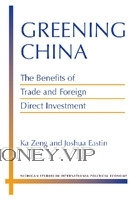
chapter 1
Theoretical Contentions and Analytical Approaches
The debate over the effects of trade liberalization and foreign direct investment
(FDI), or economic “globalization,” on environmental protection has generated
intense scrutiny from environmentalists, policymakers, and academics alike.
On the one hand, many economists and globalization proponents contend that
the economic gains captured from free trade and FDI offset environmental
damage by increasing host-country wealth. In their view, increased wealth em-
powers citizens and enables higher levels of domestic investment in environ-
mental protection. On the other hand, environmentalists and trade critics ar-
gue that a reduction of trade barriers and an increase in FDI should increase
environmental pollution, especially in less-developed countries (LDCs) that
lack the willingness or capacity to maintain stringent environmental regula-
tion. They argue that in order to remain competitive in a global environment,
developing-country governments have incentive to reduce environmental reg-
ulatory standards to attract increased levels of foreign investment and maintain
competitiveness in export markets. This process generates a “race to the bot-
tom” (RTB) among political jurisdictions competing for investment and low-
cost export production. Investors motivated by cost savings seek out these “pol-
lution havens” (PH) to establish production operations, creating a vicious
circle of diminishing regulation and increasing pollution.
China is a key front in this debate. Yet, analysts have generated surprisingly
little empirical evidence from China to inform it. It’s even more surprising
given China’s phenomenal economic growth, its increasing integration into the
global economy, and its ability to affect both the global ecology and global en-
vironmental negotiations. This project seeks to ‹ll this lacuna through an ex-
tensive, multimethod empirical examination of the effects of increasing trade
and investment on the Chinese environment.
Our results challenge both the pollution-haven and the race-to-the-bottom
hypotheses. We ‹nd that foreign ‹rms do not seek out pollution havens in
China. Nor do Chinese provinces lower environmental standards to attract for-
eign investment. We ‹nd that trade can actually increase the ‹nancial incen-
tives of export-oriented ‹rms to self-regulate environmental performance to
developed-world regulatory standards in the mode of the California Effect.
Further, we ‹nd that FDI from the developed world conveys superior regula-
tory standards from parent company to subsidiary and facilitates the interna-
tional diffusion and spillover of environmentally cleaner technology. Ulti-
mately, we expect increasing trade and investment to lead to an overall
improvement in Chinese environmental health. However, as our book elabo-
rates, it matters whom the trade is with, and where the FDI originates. The fol-
lowing sections provide an overview of our project and detail our key theoret-
ical contentions. background and overview of the project
Unfortunately, China’s remarkable economic growth in recent decades has
been accompanied by considerable environmental externalities. China is cur-
rently experiencing environmental degradation on a monumental scale. Indus-
trial, agricultural, and municipal pollution is at or exceeding catastrophic levels
for much of the Chinese population. In its rush toward economic moderniza-
tion, China absorbed the products and processes that fueled similar industrial-
izations in the United States and Europe, but in a world more vulnerable to
their costs. The costs, both ‹nancial and human, have been high. Recent reports
from China’s State Environmental Protection Administration (SEPA) claim
that environmental pollution costs the Chinese economy approximately 10 per-
cent of annual gross domestic product (GDP), though some estimates measure
the actual cost, in terms of human life and livelihood, to be much higher.
Environmental pollution is manifested in different forms, with the most se-
rious threats arising from industrial, agricultural, and municipal air and water
pollution. These threats are both local and global in nature. According to the
Netherlands Environmental Assessment Agency, China is the largest overall
emitter of greenhouse gases in the world and emits roughly twice the amount
of sulfur dioxide and particulate matter as does the United States.
Greening China: The Benefits of Trade and Foreign Direct Investment by Zeng Ka and Eastin Joshua




